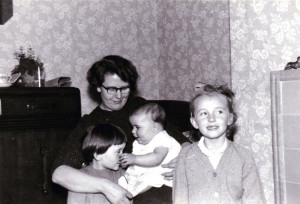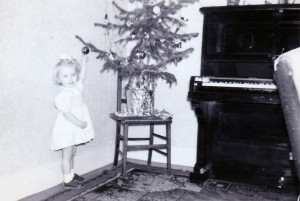
I am standing in front of a Morphy Richards Convector Heater, shivering slightly, as the heater is struggling to have any impact on my freezing cold bedroom. I put on my clothes as quickly as possible, but not without taking pleasure in them – the grey, black and white kilt, the sage-green cardigan knitted for me for Christmas by my Aunty Maud. The cardigan’s delicate pale green hue seems to merge with the frost outside. The cardigan is winter and the antidote to winter at the same time. It is also a kind of protection, not just against the cold but against all the terrors of childhood. The days when I wear the sage-green cardigan are bound to be good days; nothing bad can happen, there can be no bullying in the playground, no teasing in the cloakroom, no frightening sums in the arithmetic lesson. On sage-green days my best friend will still be my best friend at going home time, I will not have to do games or gym, I will get through arithmetic without attracting the teacher’s attention, and perhaps be able to write a long story, or paint.
Aunty Maud must have been thinking very hard about me when she chose the sage-green wool. Maud still lived at number 65 Ettingshall Road, the Victorian terraced house where she and my father had grown up. The house was hard work – lots of tiled floors to polish, an outside lavatory and just one cold tap in the kitchen. My cousin Karen and I were convinced the house was haunted. We were sure that the picture in Maud’s bedroom (a copy of Holman Hunt’s ‘The Light of the World’) came alive at night and that the ghostly figure jumped out and floated round the room. ‘You’ve been reading too many fairy stories you have’, Maud would say, and would take us to Church with her the next morning in the hope that a burst of stern Anglicanism would banish such fantasies from our childish minds. Even though Maud did not go in for ghost stories, we loved her. We were happy just to be with her, because it was Maud who was the light of our world, and her light was golden and warm and kind.
The cardigan had some of that light knitted into it. But it was even more than that. It reminded me during the long and testing schooldays that there was another world to go back to, an old-fashioned world where I could have tea with my aunts and uncles and Granddad in Aunty Maud’s back room, and feel completely safe. The room was dark and small, and a thick curtain hid the staircase that led up to the ‘haunted’ bedrooms. The table would have a white cloth on it, and brown glass bowls for jelly and evaporated milk. There would be bread and butter, and perhaps ham or Aunty Maud’s home-made brawn. In one dish, there would be spring onions in malt vinegar, in another a few sliced tomatoes. After tea Karen and I would flit between this room, where the adults sat talking in front of the fire, and the front room, or Maud’s bedroom, where we could have adventures.
One day when I was about ten, Aunty Maud came into the front room, and asked us what we were doing. ‘Just playing,’ we said. Maud looked at me half smiling, ‘it’ll soon be time for work, not play for you’. I wondered what she meant, whether she was going to set me to polishing the brightly coloured tiles in the hall, or boiling the pig’s head for the brawn. My mother told me that Aunty Maud knew how to do things like laying the tea table properly because she had been ‘in service’. I wasn’t quite sure what this meant, but I did know it meant being away from home, and lots of hard work. And I knew it was not going to happen to me, because I lived in a bright modern house, had a convector heater in my bedroom, and almost as many outfits (at least four, including my school uniform) as the paper doll on the back page of my Bunty comic. And sometimes my mother pretended I was a princess when she woke me up, and that she was brushing my long golden hair and laying out the ball gown for me to put on. And even though the ‘ball gown’ was woolly and green, when I put it on I knew that unlike Aunty Maud, one day I would go to the ball.

